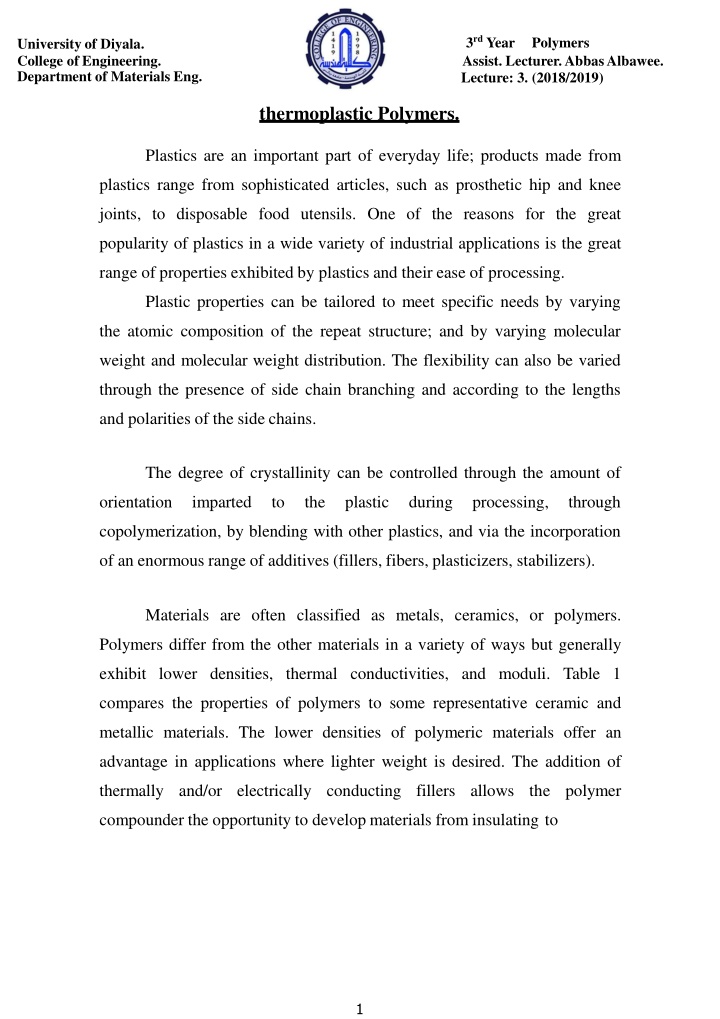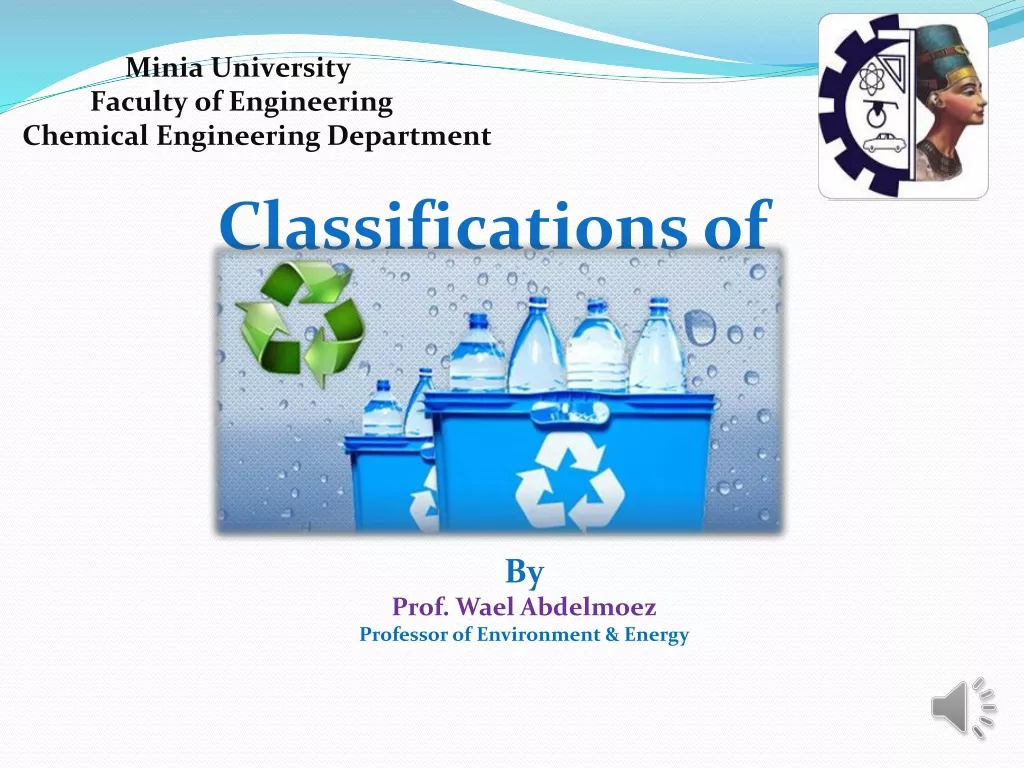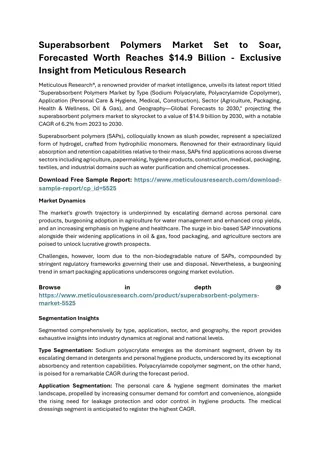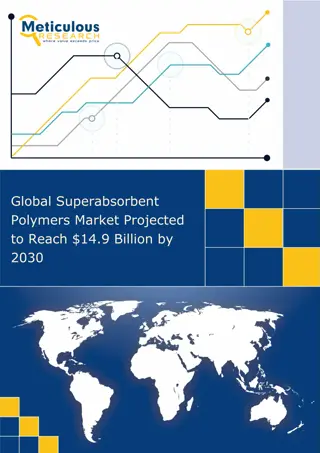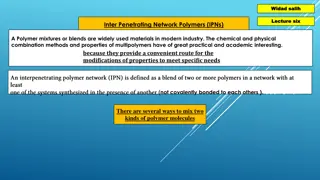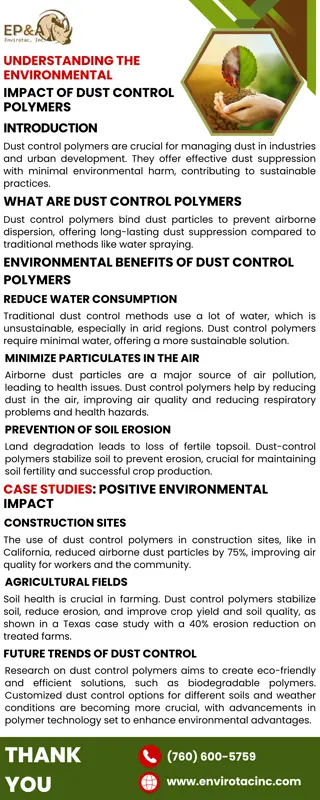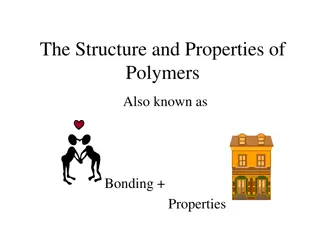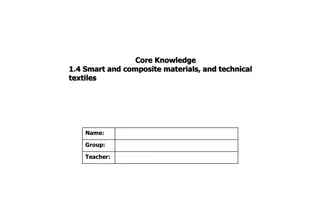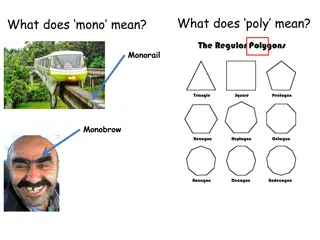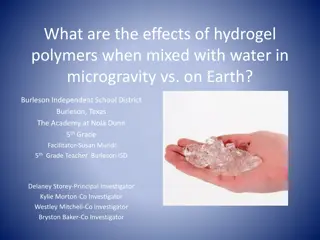Polymers in Everyday Life
Products made from polymers exhibit a wide range of properties, offering versatility and ease of processing. Understanding polymer structure, synthesis, and classification is crucial for various industrial applications. Explore the differences between thermoplastic and thermoset polymers, as well as the impact of molecular composition on polymer properties. Learn about polymerization approaches and the diverse applications of polymers in modern society.
Download Presentation

Please find below an Image/Link to download the presentation.
The content on the website is provided AS IS for your information and personal use only. It may not be sold, licensed, or shared on other websites without obtaining consent from the author.If you encounter any issues during the download, it is possible that the publisher has removed the file from their server.
You are allowed to download the files provided on this website for personal or commercial use, subject to the condition that they are used lawfully. All files are the property of their respective owners.
The content on the website is provided AS IS for your information and personal use only. It may not be sold, licensed, or shared on other websites without obtaining consent from the author.
E N D
Presentation Transcript
3rdYear Assist. Lecturer. Abbas Albawee. Lecture: 3. (2018/2019) Polymers University of Diyala. College of Engineering. Department of Materials Eng. thermoplastic Polymers. Plastics are an important part of everyday life; products made from plastics range from sophisticated articles, such as prosthetic hip and knee joints, to disposable food utensils. One of the reasons for the great popularity of plastics in a wide variety of industrial applications is the great range of properties exhibited by plastics and their ease of processing. Plastic properties can be tailored to meet specific needs by varying the atomic composition of the repeat structure; and by varying molecular weight and molecular weight distribution. The flexibility can also be varied through the presence of side chain branching and according to the lengths and polarities of the side chains. The degree of crystallinity can be controlled through the amount of orientation imparted to the plastic during processing, through copolymerization, by blending with other plastics, and via the incorporation of an enormous range of additives (fillers, fibers, plasticizers, stabilizers). Materials are often classified as metals, ceramics, or polymers. Polymers differ from the other materials in a variety of ways but generally exhibit lower densities, thermal conductivities, and moduli. Table 1 compares the properties of polymers to some representative ceramic and metallic materials. The lower densities of polymeric materials offer an advantage in applications where lighter weight is desired. The addition of thermally and/or electrically conducting fillers allows the polymer compounder the opportunity to develop materials from insulating to 1
conducting. As a result, polymers may find application in electromagnetic interference (EMI) shielding and antistatic protection. Polymer Structure and Synthesis A polymer is prepared by stringing together a series of low- molecular-weight species (such as ethylene) into an extremely long chain (polyethylene), much as one would string together a series of bead to make a necklace (Fig. 1). The chemical characteristics of the starting low- molecular-weight species will determine the properties of the final polymer. When two different low-molecular-weight species are 2
polymerized the resulting polymer is termed a copolymer such as ethylene vinylacetate. This is depicted in Fig. 2. Plastics can also be separated into thermoplastics and thermosets. A thermoplastic material is a high-molecular-weight polymer that is not cross- linked. It can exist in either a linear or a branched structure. Upon heating, thermoplastics soften and melt, which allows them to be shaped using plastics processing equipment. A thermoset has all of the chains tied together with covalent bonds in a three dimensional network (cross-linked). Thermoset materials will not flow once cross-linked, but a thermoplastic material can be reprocessed simply by heating it to the appropriate temperature. The different types of structures are shown in Fig. 3. The properties of different polymers can vary widely; for example, the modulus can vary from 1 MPa to 50 GPa. Properties can be varied for each individual plastic material as well, simply by varying the microstructure of the material. There are two primary polymerization approaches: step- reaction polymerization and chain-reaction polymerization. In step-reaction (also referred to as condensation polymerization), reaction occurs between two polyfunctional monomers, often liberating a small molecule such as water. As the reaction proceeds, higher-molecular-weight species are produced as longer and longer groups react together. For example, two monomers can react to form a dimer, then react with another monomer to form a trimmer. The reaction can be described as n-mer t m-mer > (n + n )mer, where n and m refer to the number of monomer units for each reactant. Molecular weight of the polymer builds up gradually with time, and high conversions are usually required to produce high-molecular- weight polymers. Polymers synthesized by this method typically have 3
atoms other than carbon in the backbone. Examples include polyesters and polyamides. Figure 1.1 Polymerization. Figure 1.2 Copolymer structure. Branched linear Cross-linked Figure 1.3 Linear, branched, and cross-linked polymer structure Chain-reaction polymerizations (also referred to as addition polymerizations,) require an initiator for polymerization to occur. Initiation can occur by a free radical or an anionic or cationic species, which opens the double bond of a vinyl monomer and the reaction proceeds as shown above in Fig. 1. Chain-reaction polymers typically contain only carbon in their backbone and include such polymers as polystyrene and polyvinyl chloride. 4
Glass Transition Temperature (Tg) Polymers come in many forms, including plastics, rubber, and fibers. Plastics are stiffer than rubber yet have reduced low-temperature properties. Generally, a plastic differs from a rubbery material due to the location of its glass transition temperature (Tg), which is the temperature at which the polymer behavior changes from glassy to leathery. A plastic has a Tg above room temperature, whereas a rubber has a Tg below room temperature. Tg is most clearly defined by evaluating the classic relationship of elastic modulus to temperature for polymers as presented in fig. 4. At low temperatures, the material can best be described as a glassy solid. It has a high modulus, and behavior in this state is characterized ideally as a purely elastic solid. In this temperature regime, materials most closely obey Hooke slaw: where is the stress being applied, and is the strain. Young modulus, E, is the proportionality constant relating stress and strain.. In the leathery region, the modulus is reduced by up to three orders of magnitude from the glassy modulus for amorphous polymers. The rubbery plateau has a relatively stable modulus until further temperature increases induce rubbery flow. Motion at this point does not involve entire molecules, but, in this region, deformations begin to become no recoverable as permanent set takes place.As temperature is further 5
increased, eventually the onset of liquid flow takes place. There is little elastic recovery in this region, and the flow involves entire molecules slipping past each other. This region models ideal viscous materials, which obey Newton's law as follows:- Figure 4 Crystallization and Melting Behavior,Tm In its solid form, a polymer can exilibit different morphologies, depending on the structure of the polymer chainas well as the processing conditions. The polymer may exist in a random unordered structure termed amorphous. An example of an amorphous polymer is polystyrene. If the structure of the polymer backbone is a regular, ordered structure, then the polymer can tightly pack into an ordered crystalline structure, although the material will generally be only semi crystalline. Examples are polyethylene and polypropylene. The exact makeup and architecture of the polymer 6
backbone will determine whether the polymer is capable of crystallizing. This microstructure can be controlled by different synthetic methods. As mentioned above, the Ziegler-Natta catalysts are capable of controlling the microstructure to produce stereospecific polymers. The types of microstructure that can be obtained for a vinyl polymer are shown in Fig.5. The isotactic and syndiotactic structures are capable of crystallizing because of their highly regular backbone. The atactic form is amorphous. Isotactic Syndiotactic Atactic Fig. 5. Mechanical Properties The mechanical behavior of polymers is dependent on many factors, including polymer type, molecular weight, and test procedure. Modulus values are obtained from a standard tensile test with a given rate of crosshead separation. In the linear region, the slope of a stress-strain curve will give the elastic or Young modulus, E. 7
Viscoelasticity Polymer properties exhibit time-dependent behavior, which is dependent on the test conditions and polymer type. Figure 6, shows a typical viscoelastic response of a polymer to changes in testing rate or temperature. Increases in testing rate or decreases in temperature cause the material to appear more rigid, while an increase in temperature or decrease in rate will cause the material to appear softer. This time-dependent behavior can also result in long-term effects such as stress relaxation or creep. Fig. 6. These two time-dependent behaviors are shown in Fig. 7. Under a fixed displacement, the stress on the material will decrease over time, and this is called stress relaxation. 8
Fig. 7. This behavior can be modeled using a spring and dashpot in series as depicted in Fig. 8. The equation for the time dependent stress using this model is: Fig.8. 9
where is the characteristic relaxation time (/k). Under a fixed load, the specimen will continue to elongate with time, a phenomenon termed creep, which can be modeled using a spring and dashpot in parallel as seen in Fig. 8. This model predicts the time-dependent strainas 10
